To see all the measures to be implemented, click here.
The CeBIT - Global Event for Digital Business - is the largest trade fair in Europe. From 20 – 24 March 2017 GrowSmarter partners from Cologne present the project at a joint stand together with Lighthouse City projects from Munich and Hamburg (Smarter Together and mySMARTLife). For the fair, the three cities prepared a joint appearance.
Click here for more information about the presentation.
The overview of projects, focuses and targets presented at the event was very well received by visitors. A presentation of the GrowSmarter ran in a loop at the stand. The booth was always surrounded by interested visitors, especially by industry and cities representatives. Many companies see that the approaches developed in the project can generate promising business models. Inquiries also came from representatives from other cities who want to shape sustainable urban development based on the experience of the projects presented. After CeBIT, 12 companies and 3 cities agreed on meeting dates for further exchange of experience. The successful joint appearance of Cologne, Munich and Hamburg will mean that the three cities will again be exhibited together at trade fairs in the future.
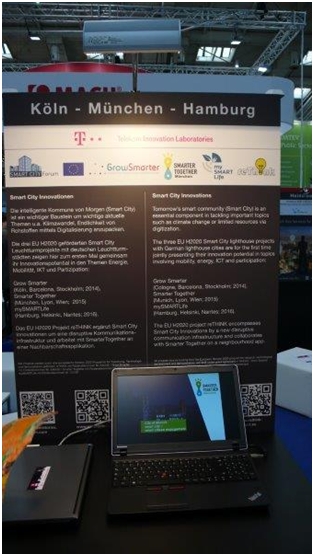
GrowSmarter Study Visit Cologne
The GrowSmarter Study Visit was a two-day event, including the SmartCity Cologne Conference on 26 April and the on-site visit at the Stegerwaldsiedlung on 27 April.
Dr. Rau (Deputy Major for Social Affairs, Integration and Environmental Affairs) welcomed the Study Visit participants in Cologne on 26th April. He gave a short introduction and overview of Cologne’s current situation in areas such as environment, demography, economy and mobility. Cologne is an important economic and cultural center in Germany, which is currently facing a dynamic growth period: its economy is thriving and its population has just surpassed one million. Therefore, Cologne faces large challenges in terms of growing mobility problems, lack of qualified workforce and increasing energy use, to name a few. Dr. Rau pointed out that extremely high traffic loads (Cologne is the city with the most traffic jams in Germany) have brought about a strategy of change in the direction of more sustainable urban development. The GrowSmarter project and the solutions found therein are testing grounds that could lead to implementation across Cologne.
Following Dr. Rau’s introduction, Dr. Barbara Möhlendick gave an overview of the Smart City Cologne initiative and projects as well as how the GrowSmarter project came to be in Cologne. Julia Egenolf presented the planned measures in GrowSmarter and the current state of their implementation.
The subsequent SmartCity conference: Köln - mobil 2025+ introduced a variety of alternative mobility concepts. Sven Plöger (German TV weatherman and keynote speaker) delivered a fascinating speech about the mechanisms and consequences of climate change related to global and local events, including the City of Cologne. The reduction of CO2 is of utmost importance and the contributions from the Cologne SmartCity projects’ energy-saving solutions, such as the GrowSmarter project, are of immense important.
Start-up entrepreneurs were also at the conference, showing how successful business models have emerged from alternative transport concepts.
At the GrowSmarter booth, Cologne showed the GrowSmarter mobility measures on a touch screen as well as an overview of all Horizon 2020 SmartCity projects since 2015. Visitors were invited to use the interactive touchscreen to learn about the individual measures in Cologne, Stockholm and Barcelona as well as the other projects, such as Triangulum, Remourban, etc.

GrowSmarter touch screen at SmartCity Cologne Conference on 26 April 2017
Day 2
On 27 April, participants toured the Stegerwaldsiedlung, where they could see energy refurbishment and alternative mobility measures implemented through GrowSmarter.
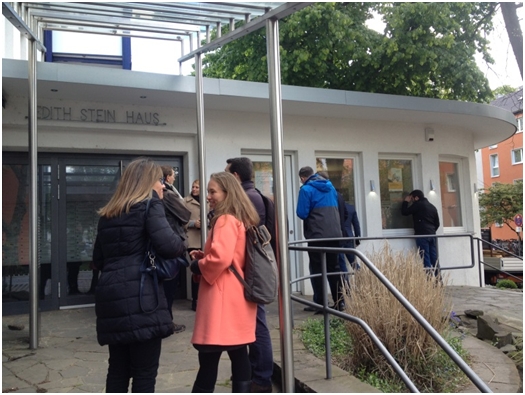
GrowSmarter study visitors at the Stegerwaldcafe, Cologne
Findings
An important outcome of the discussion with the GrowSmarter partners was the fact that solutions can only be implemented if city and industry partners cooperate closely and strive for a win-win situation. It was also clear that the success of the measures depended greatly upon clear compliance with legal frameworks.
The concept of the mobility stations – multi-modal transport hubs – was well received by participants, and several cities were interested in implementing similar stations.
The intensive exchange on the data platform led to planning of further discussions and meetings. The acquisition of data and the goal of providing as much data as possible to the citizens openly and free of charge were seen as a major challenge.
The visits to the Stegerwaldsiedlung as well as the computer centre successfully showed that complex energy-efficient solutions can be implemented within existing buildings in smart ways.
Participants positively evaluated the usefulness of the Study Visit, answering either “good” or “excellent”.
Action area 1: Low-Energy Districts
To see all the measures to be implemented, click here.
On 27 April 2017, RheinEnergie presented the current state of implementation of the measures in WP2 (Low Energy Districts) and set up a pavilion in front of the first completed buildings.
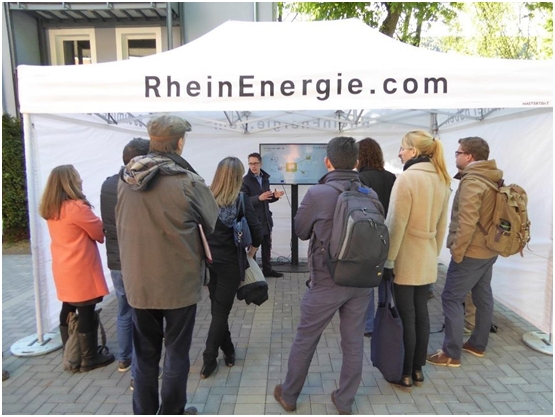
Presentation during study visit
Measures
Refurbishment
The refurbishment of the first construction phase was completed by DEWOG. The second construction phase is in progress.

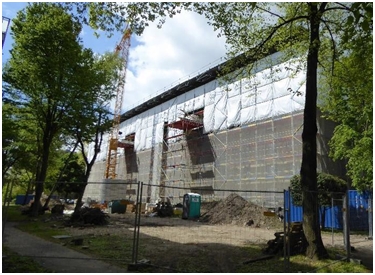
Finished buildings
Refurbishment in progress
Energy
The settlement was connected to the district heating grid and the buildings from the first construction phase have been using district heating since December 2016. The installation of heat pumps and battery storage for the first construction phase will start in May 2017.
During a tour around the settlement and in the basement, we presented the current state of the project and share our experiences gained from implementing the solutions.
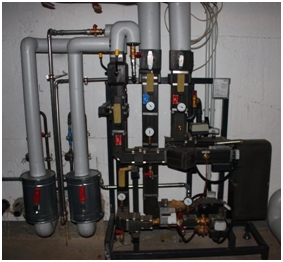
District heating station
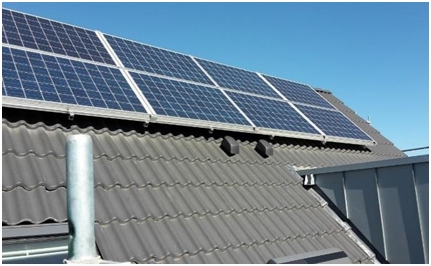
PV on the roof tops

Model of the housing for the battery storages
Furthermore, the energy management software, the “Siedlungsmanagement”, was explained in detail, including the forecasting and optimisation modules. The software is still in development, as not all of the devices that it will manage have been installed or connected yet. The system will learn from past events and self-regulate to optimise energy flow.

Structure Siedlungsmanagement
Smart Home
At the End of the presentation, the Smart Home System from RheinEnergie was presented along with a demonstration.
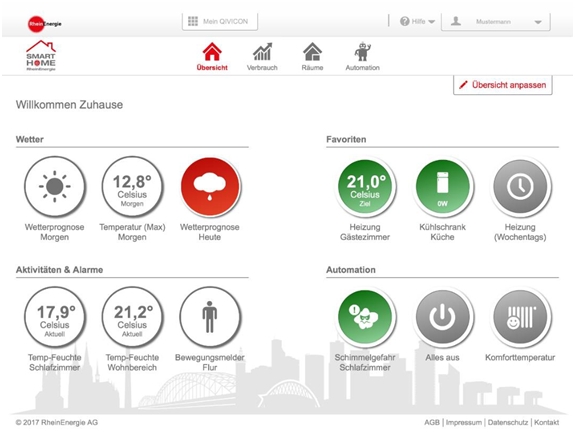
Dashboard of the Smart Home System

Smart Home System
Action area 2: Integrated Infrastructures
To see all the measures to be implemented, click here.
The evening Hackathon event on 27 April demonstrated the building and use of cost-effective environmental sensors. As all cities admitted having issues producing good-quality environmental data at acceptable costs, this was an especially relevant topic. The more citizens that use environmental sensors, the more they can help improve the city's measures for reducing air pollution.
It Cologne’s Smart City Solutions were very interesting for many other cities, who have now started developing own concepts for similar solutions, such as Nürnberg or Porto. The study visit was a good opportunity to share knowledge, findings and experiences and to get closer in touch with each other in order to transfer knowledge and results. For example, Cologne and [ui!] now have a better understanding of what the follower city Porto needs and what results might be easily transferable from Cologne to Porto.

Action area 3: Sustainable Urban Mobility
To see all the measures to be implemented, click here.
First Mobility Station Charles-de-Gaulle Square
On 27 April 2017, participants visited the mobility station “Charles-de-Gaulle Platz near the Deutz Train Station, a multi-modal transport hub that brings together various modes of public and private transport.
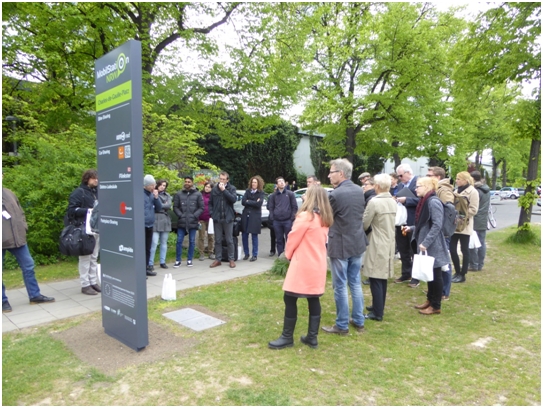
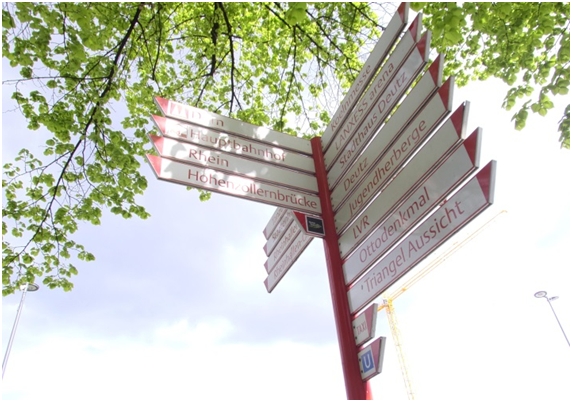
Together with the state of North Rhine-Westphalia (NRW), the city of Cologne has designed signage to identify the mobility station and the transport options available there. It’s also planned to install a mobility station sign inside the train station, which is currently under negotiation with Deutsche Bahn AG.
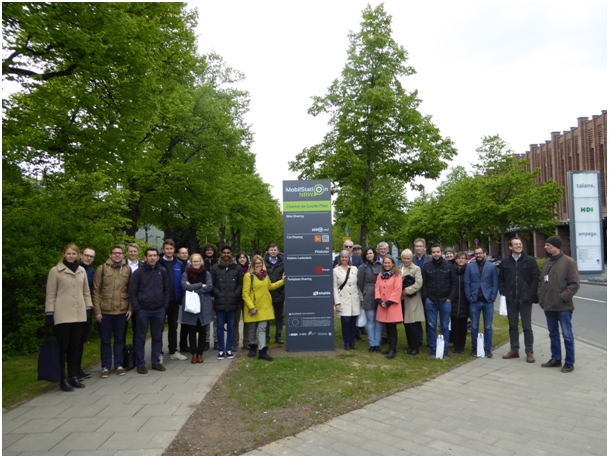
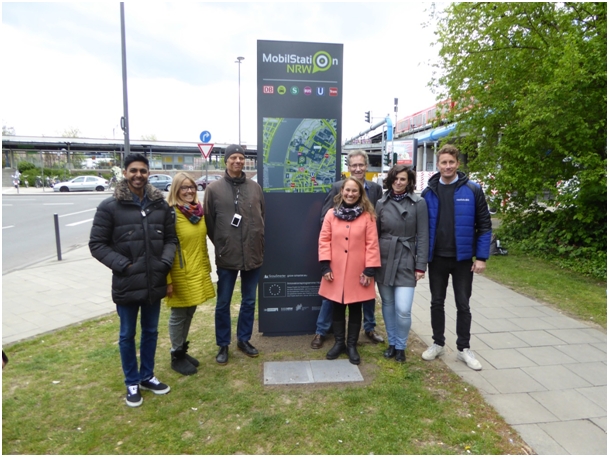
Front site Charles-de-Gaulle Platz
Front site Charles-de-Gaulle Platz, view to train station in background
The station for (e-) bike sharing is expected to be built in the fourth quarter of 2017. The intended location is between the ampido station and the public charging points. Until now, KVB-AG has already been operating a conventional bicycle rental system.

KVB-Bike started in May 2015 as a free float system. Today there are nearly 1,500 bikes in circulation across an area of 84 km2. It is integrated in the public transport systemof Cologne and the surrounding area.
But what does “integrated” really mean? Regular public transportation customers receive annual passes as an e-Ticket on a smartcard and soon on a smartphone too. Over 600,000 people are now e-Ticket holders. With that e-Ticket, customers get access to public transportation, KVB-Bike and probably in autumn to CambioCarsharing. This means that with one e-Ticket, they receive access to many different vehicles. In the case of KVB-Bike, customers can register for the service directly at the bike by holding their e-Ticket on a card-reader attached to the bike. After providing a mobile phone number and accepting the terms and conditions, a 6-digit PIN is sent via SMS and the bike lock opens automatically. Once successfully registered, customers are able to rent a bike via eTicket + PIN, phone number + PIN, or a smartphone app.
In June 2016, KVB started construction and implementation of 100 bike sharing stations, mostly at tram and mobility stations. The system will now be operated as a mixed system, with free-float bikes as well as a fixed station, and offering conventional bikes as well as e-Bikes. Especially with e-bikes, KVB faces some challenges: today e-bikes are still not really suitable for public bike sharing systems due to cost and vulnerability to vandalism and theft. Requirements for public E-Bikesharing system are:
- Solid and reliable e-bikes in operation
- Cheap in procurement and maintenance
- Easy access just like a standard bike (no enclosures)
- Mixed operation with standard bikes
- Operating mode: free-float and station-based
- Year-round operation
A KVB e-bike is still in the development phase, with a prototype to become available in 2017.
The first e-bus project started in 2014. KVB AG ordered eight articulated, full-electric buses. Because of the high additional costs compared to a diesel bus, KVB needed financial assistance. The total contribution for the project was € 1.92 million. There are two interfaces for charging the vehicles. The first one is the pantograph; it is placed on the roof of the vehicle and is used for fast charging with 240 kW at both end points of the bus route. The second charging interface is designed for slow charging at the depot via cable and CCS connectors with 50 kW charging power. We needed to make some adjustments at the workshop for the electric buses. For example we needed a frame for working on the roofs of the buses, insulated tools, personal protective equipment, and an overhead crane.
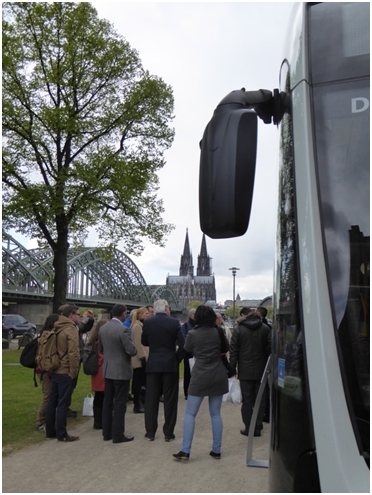
(E-)Car-Sharing
The company Cambio is currently operating a car sharing scheme on Charles de Gaulle square with a total of 5 parking spaces. The charging infrastructure allows Cambio to operate a total of three electric vehicles and two conventional vehicles at this location.
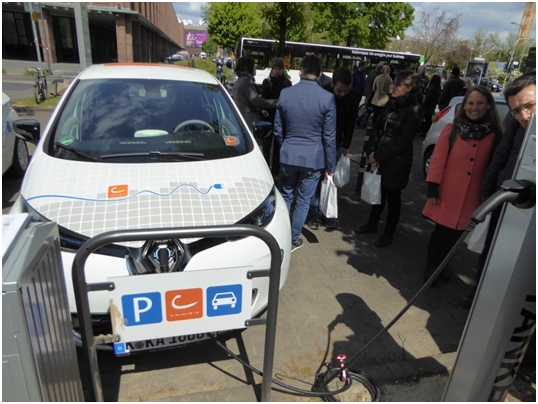
Cambio explained the registration process for car sharing during the study visit. It was particularly interesting for the participants to learn how quickly one can use vehicles after registration. Tanya Bullmann gave a brief overview of the future planned online validation possibilities via camera, followed by a demonstration of how easily and comfortably the vehicles can be booked and borrowed. Participants were particularly curious about the networking possibilities with other forms of mobility. Cambio explained the concept of the mobile ticket planned together with KVB for 2017. This idea was received very positively by the participants. Following the presentation of the electric vehicles, RheinEnergie presented the corresponding charging technology for the e-vehicles.
Online parking space management
Ampido currently operates its online parking management system all across town at many privately owned parking spaces. For the duration of the GrowSmarter project, the state of North Rhine-Westphalia allowed ampido to introduce its system at three mobility station locations on public land, so far with a total of five parking spaces.
In their presentation, ampido noted that the pilot project reduces CO2, reduces time spent searching for parking spaces, and can even lower parking prices. By using the parking app, we can get rid of parking ticket machines and achieve faster cost coverage, leading to reduced parking prices. The e-charging stations from RheinEnergie are a practical addition: customers can reserve not only a parking space but also a charging location. With this combination, CO2 savings are improved further.

Public Charging Infrastructure
Two public charging columns provide charging interfaces for a total of four electric vehicles. Non-electric vehicles are forbidden from using these parking spaces.
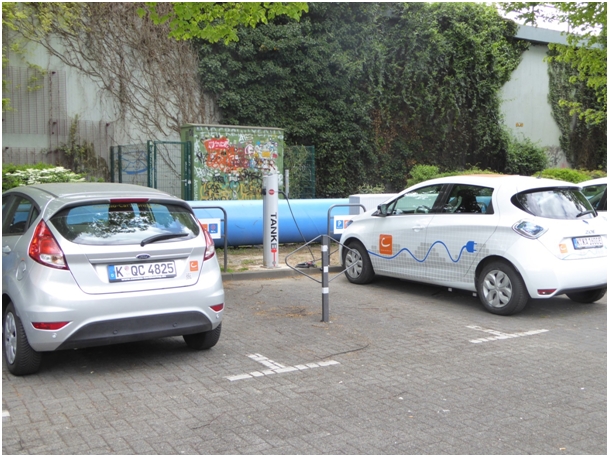
The company cleverciti was commissioned by RheinEnergie AG to install sensors for parking space monitoring at Charles de Gaulle-Square. The sensors hang on the public lighting and transmit data in real time, which is available at: http://system.cleverciti.com/koeln/



